Microstructures of HfOx Films Prepared via Atomic Layer Deposition Using La(NO3)3·6H2O Oxidants
Abstract
:1. Introduction
2. Materials and Methods
2.1. HfOx Film Fabrication
2.2. Analyses of HfOx Thin Films Properties
3. Results and Discussion
3.1. ALD Process for HfOx Film Growth Using LNS
3.2. Microstructure of HfOx Films Prepared Using LNS
3.3. Chemical Bonding and Elemental Content of HfO2 Films Deposited Using LNS
3.4. Relationship between Surface Energy and Crystalline Properties
4. Conclusions
Author Contributions
Funding
Conflicts of Interest
References
- Tsai, Y.-H.; Chou, C.-H.; Chung, Y.-Y.; Yeh, W.-K.; Lin, Y.-H.; Ko, F.-H.; Chien, C.-H. Demonstration of HfO2-based gate dielectric with low interface state density and sub-nm EOT on Ge by incorporating Ti into interfacial layer. IEEE Electron Device Lett. 2019, 40, 174–176. [Google Scholar] [CrossRef]
- Jung, Y.C.; Seong, S.; Lee, T.; Kim, S.Y.; Park, I.-S.; Ahn, J. Improved resistive switching characteristics of a Pt/HfO2/Pt resistor by controlling anode interface with forming and switching polarity. Appl. Surf. Sci. 2018, 435, 117–121. [Google Scholar] [CrossRef]
- Schroeder, U.; Richter, C.; Park, M.H.; Schenk, T.; Pesic, M.; Hoffmann, M.; Fengler, F.P.G.; Pohl, D.; Rellinghaus, B.; Zhou, C.; et al. Lanthanum-doped hafnium oxide: A robust ferroelectric material. Inorg. Chem. 2018, 57, 2752–2765. [Google Scholar] [CrossRef] [PubMed]
- Fan, Z.; Chen, J.; Wang, J. Ferroelectric HfO2-based materials for next-generation ferroelectric memories. J. Adv. Dielectr. 2016, 6, 1630003. [Google Scholar] [CrossRef] [Green Version]
- Johnson, R.W.; Hultqvist, A.; Bent, S.F. A brief review of atomic layer deposition: From fundamentals to applications. Mater. Today 2014, 17, 236–246. [Google Scholar] [CrossRef]
- Park, I.-S.; Jung, Y.C.; Seong, S.; Ahn, J.; Kang, J.; Noh, W.; Lansalot-Matras, C. Atomic layer deposition of Y2O3 films using heteroleptic liquid (iPrCp)2Y(iPr-amd) precursor. J. Mater. Chem. C 2014, 2, 9240–9247. [Google Scholar] [CrossRef]
- Granneman, E.; Fischer, P.; Pierreux, D.; Terhorst, H.; Zagwijn, P. Batch ALD: Characteristics, comparison with single wafer ALD, and examples. Surf. Coat. Tech. 2007, 201, 8899–8907. [Google Scholar] [CrossRef]
- Muñoz-Rojas, D.; Huong Nguyen, V.; Masse de la Huerta, C.; Jiménez, C.; Bellet, D. Spatial Atomic Layer Deposition. In Chemical Vapor Deposition for Nanotechnology; Mandracci, P., Ed.; IntechOpen: London, UK, 2019; pp. 1–25. [Google Scholar]
- Januar, M.; Prakoso, S.P.; Lan, S.-Y.; Mahanty, R.K.; Kuo, S.-Y.; Liu, K.-C. The role of oxygen plasma in the formation of oxygen defects in HfOx films deposited at room temperature. J. Mater. Chem. C 2015, 3, 4104–4114. [Google Scholar] [CrossRef]
- Oh, N.K.; Kim, J.-T.; Kang, G.; An, J.-K.; Nam, M.; Kim, S.Y.; Park, I.-S.; Yun, J.-Y. Oxidant effect of La(NO3)3·6H2O solution on the crystalline characteristics of nanocrystalline ZrO2 films grown by atomic layer deposition. Appl. Surf. Sci. 2017, 394, 231–239. [Google Scholar] [CrossRef]
- Jung, Y.C.; Park, I.-S.; Seong, S.; Lee, T.; Kim, S.Y.; Ahn, J. Enhanced resistive switching characteristics of HfOx insulator fabricated by atomic layer deposition and La(NO3)3·6H2O solution as catalytic oxidant. J. Vac. Sci. Technol. A 2020, 38, 032405. [Google Scholar] [CrossRef]
- Park, I.-S.; Lee, T.; Choi, D.-K.; Ahn, J. Metal precursor effects on deposition and interfacial characteristics of HfO2 dielectrics grown by atomic layer deposition. J. Korean Phys. Soc. 2006, 49, S544–S547. [Google Scholar]
- Chiou, Y.-K.; Chang, C.-H.; Wu, T.-B. Characteristics of hafnium oxide grown on silicon by atomic-layer deposition using tetrakis(ethylmethylamino)hafnium and water vapor as precursors. J. Mater. Res. 2007, 22, 1899–1906. [Google Scholar] [CrossRef]
- Jung, Y.C.; Seong, S.; Lee, T.; Kim, S.Y.; Park, I.-S.; Ahn, J. Effects of hydrogen annealing temperature on the resistive switching characteristics of HfOx thin films. Mater. Sci. Semicond. Process. 2018, 88, 207–213. [Google Scholar] [CrossRef]
- Barreca, D.; Milanov, A.; Fischer, R.A.; Devi, A.; Tondello, E. Hafnium oxide thin film grown by ALD: An XPS study. Surf. Sci. Spectra 2007, 14, 34–40. [Google Scholar] [CrossRef]
- Tan, T.; Guo, T.; Wu, Z.; Liu, Z. Charge transport and bipolar switching mechanism in a Cu/HfO2/Pt resistive switching cell. Chin. Phys. B 2016, 25, 117306. [Google Scholar] [CrossRef]
- Zhang, W.; Kong, J.-Z.; Cao, Z.-Y.; Li, A.-D.; Wang, L.-G.; Zhu, L.; Li, X.; Cao, Y.-Q.; Wu, D. Bipolar resistive switching characteristics of HfO2/TiO2/HfO2 trilayer-structure RRAM devices on Pt and TiN-coated substrates fabricated by atomic layer deposition. Nanoscale Res. Lett. 2017, 12, 393. [Google Scholar] [CrossRef] [PubMed]
- Chung, J.; Tak, Y.J.; Kim, W.-G.; Park, J.W.; Kim, T.S.; Lim, J.H.; Kim, H.J. Low-temperature fabrication of solution-processed hafnium oxide gate insulator films using a thermally purified solution process. J. Mater. Chem. C 2018, 6, 4928–4935. [Google Scholar] [CrossRef]
- Luo, X.; Li, Y.; Yang, H.; Liang, Y.; He, K.; Sun, W.; Lin, H.-H.; Yao, S.; Lu, X.; Wan, L.; et al. Investigation of HfO2 thin films on Si by X-ray photoelectron spectroscopy, Rutherford backscattering, grazing incidence X-ray diffraction and variable angle spectroscopic ellipsometry. Crystals 2018, 8, 248. [Google Scholar] [CrossRef] [Green Version]
- Atuchin, V.V.; Kalinkin, A.V.; Kochubey, V.A.; Kruchinin, V.N.; Vemuri, R.S.; Ramana, C.V. Spectroscopic ellipsometry and x-ray photoelectron spectroscopy of La2O3 thin films deposited by reactive magnetron sputtering. J. Vac. Sci. Technol. A 2011, 29, 021004. [Google Scholar] [CrossRef]
- Michiardi, A.; Aparicio, C.; Ratner, B.D.; Planell, J.A.; Gil, J. The influence of surface energy on competitive protein adsorption on oxidized NiTi surfaces. Biomaterials 2007, 28, 586–594. [Google Scholar] [CrossRef] [PubMed]
- Hayami, W.; Otani, S. The role of surface energy in the growth of boron crystals. J. Phys. Chem. C 2007, 111, 688–692. [Google Scholar] [CrossRef]
- Penn, R.L.; Banfield, J.F. Morphology development and crystal growth in nanocrystalline aggregates under hydrothermal conditions: Insight from titania. Geochim. Cosmochim. Acta 1999, 63, 1549–1557. [Google Scholar] [CrossRef]
- Mukhopadhyay, A.B.; Sanz, J.F.; Musgrave, C.B. First-principles calculations of structural and electronic properties of monoclinic hafnia surfaces. Phys. Rev. B 2006, 73, 115330. [Google Scholar] [CrossRef]
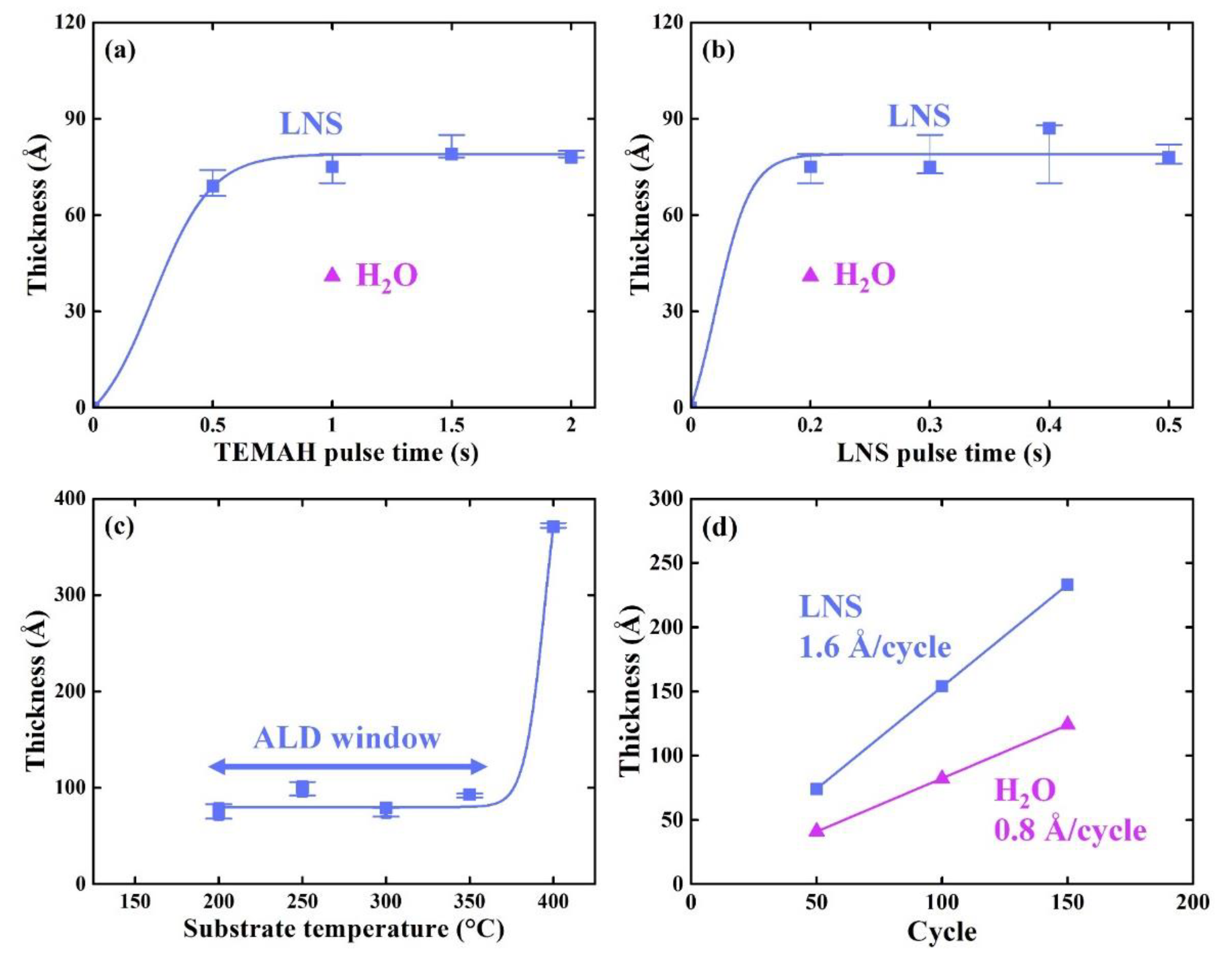
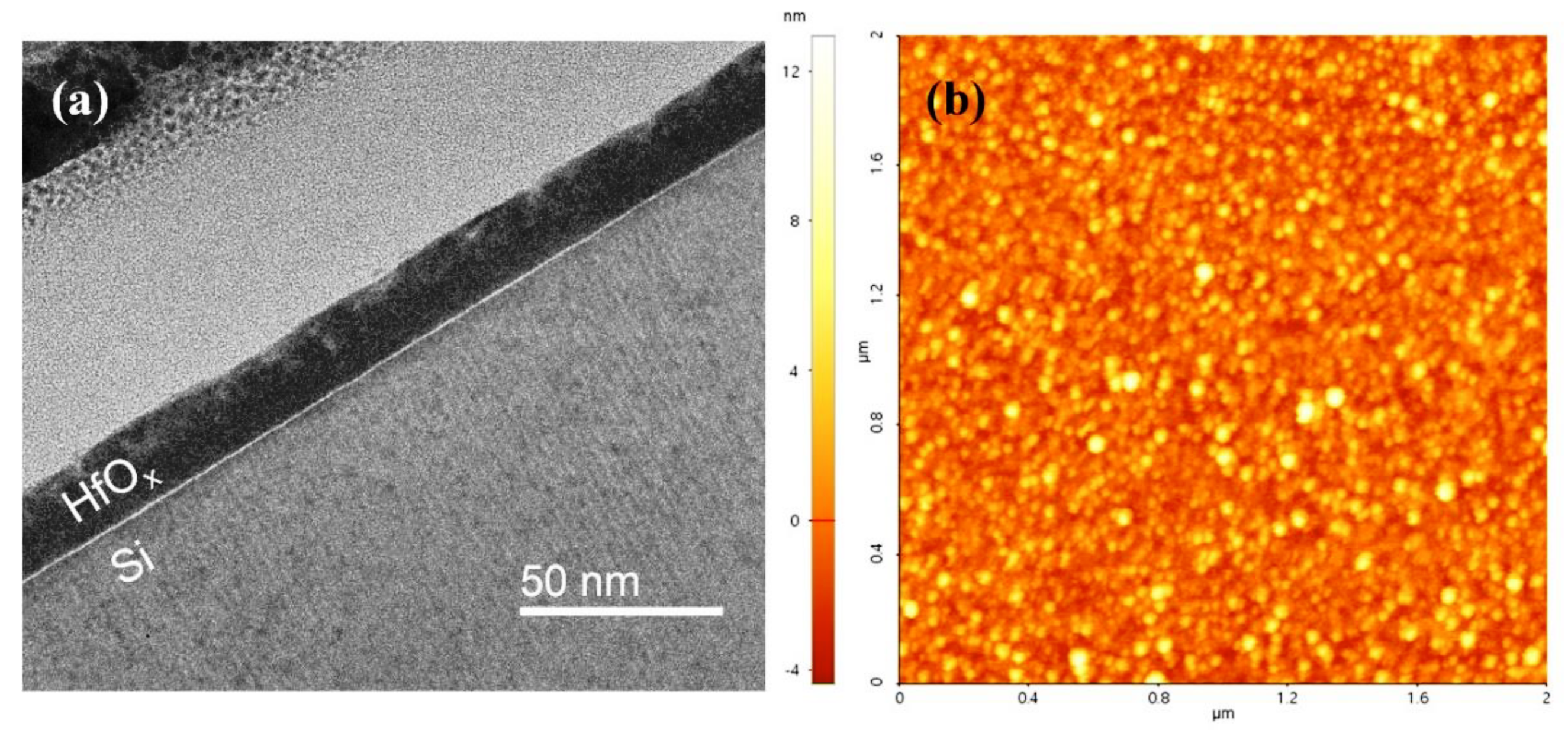
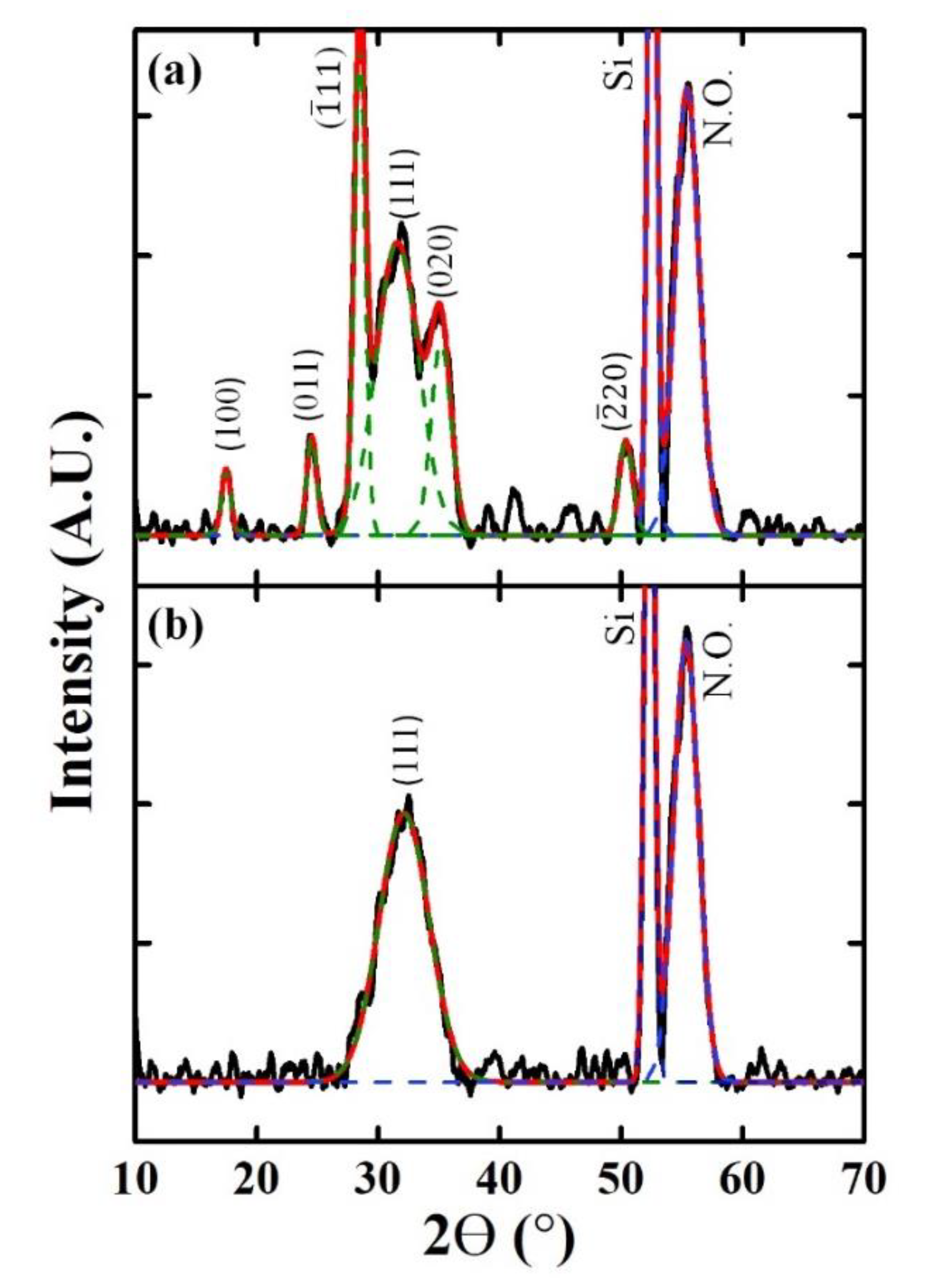
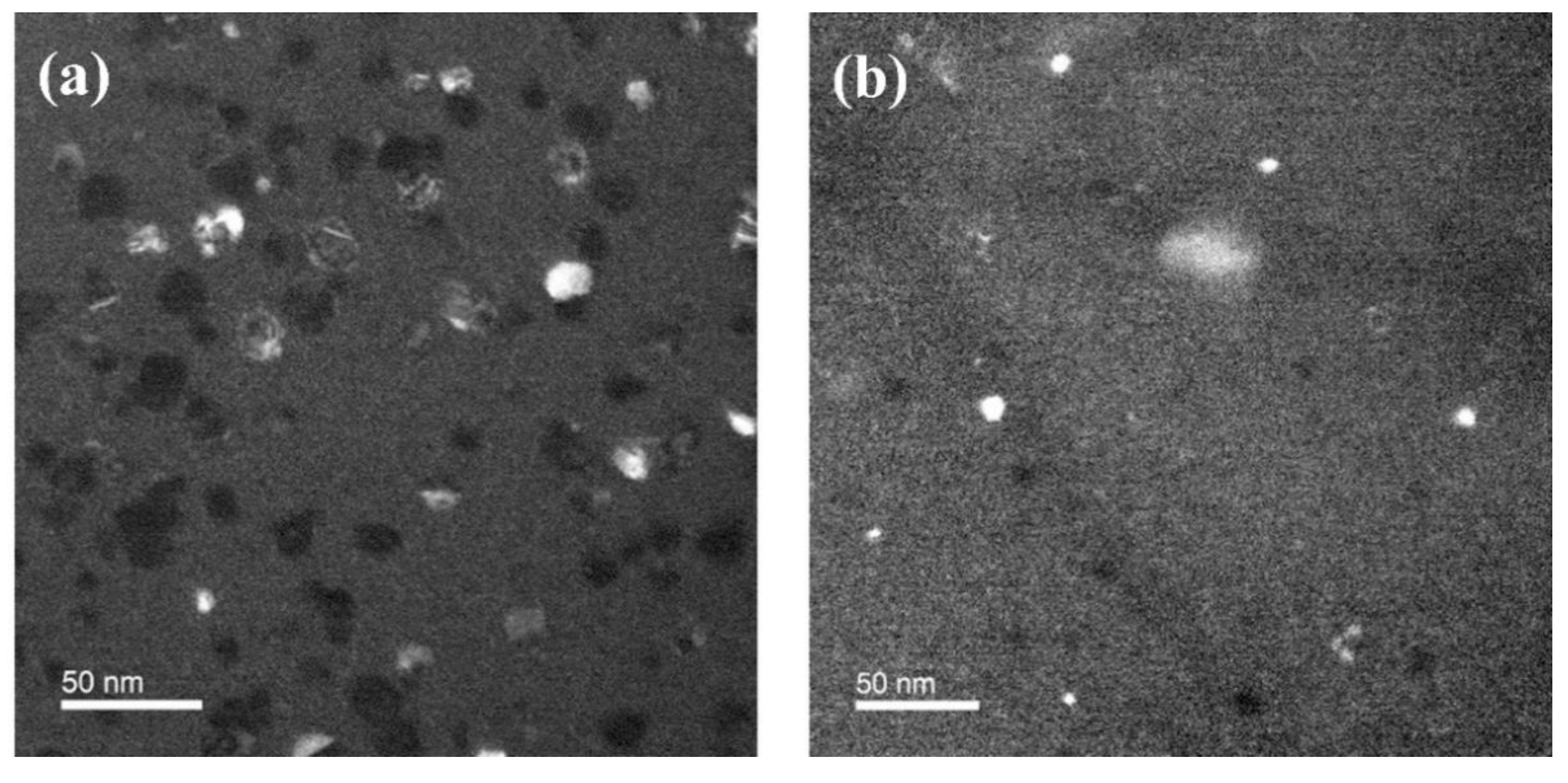
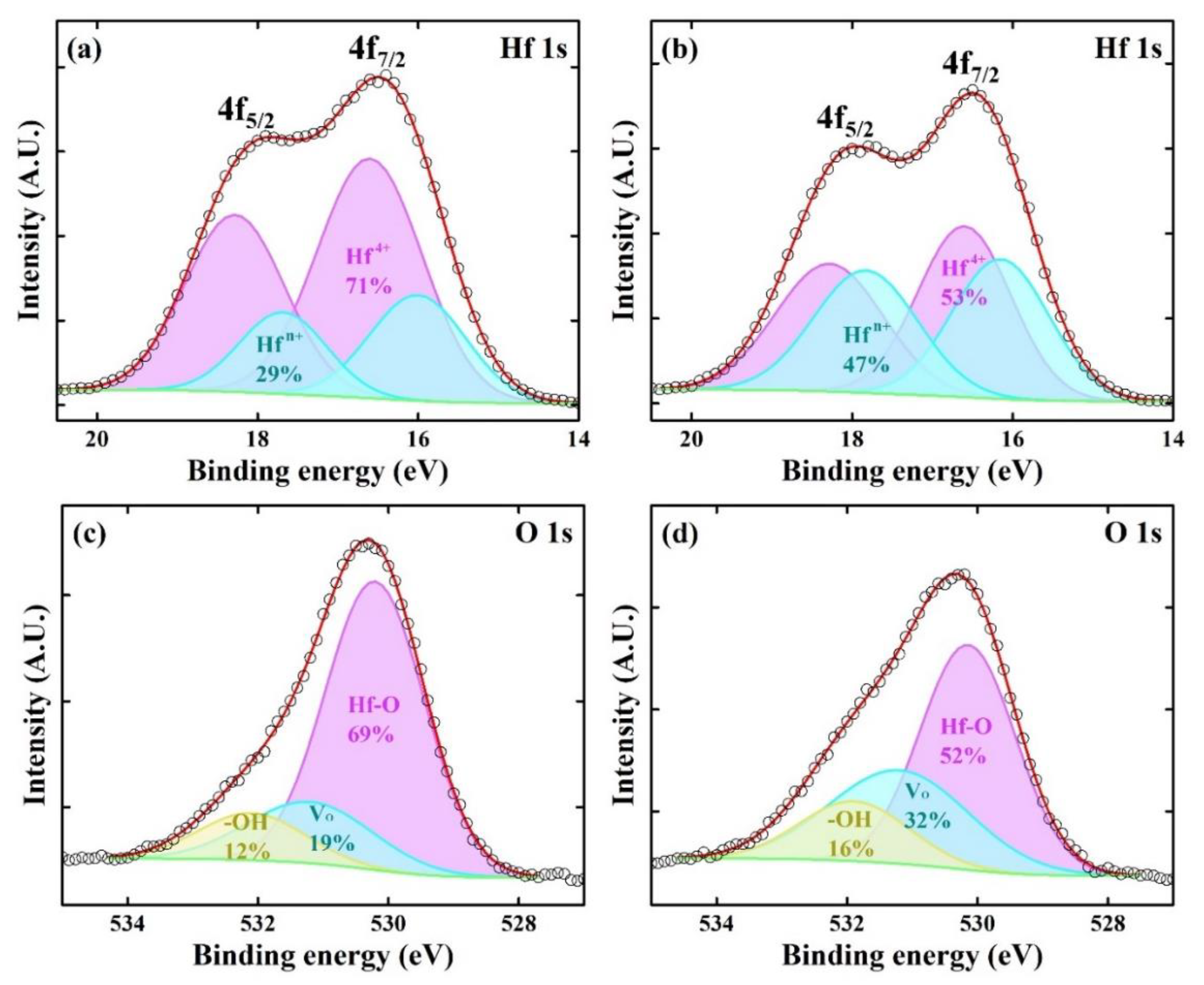
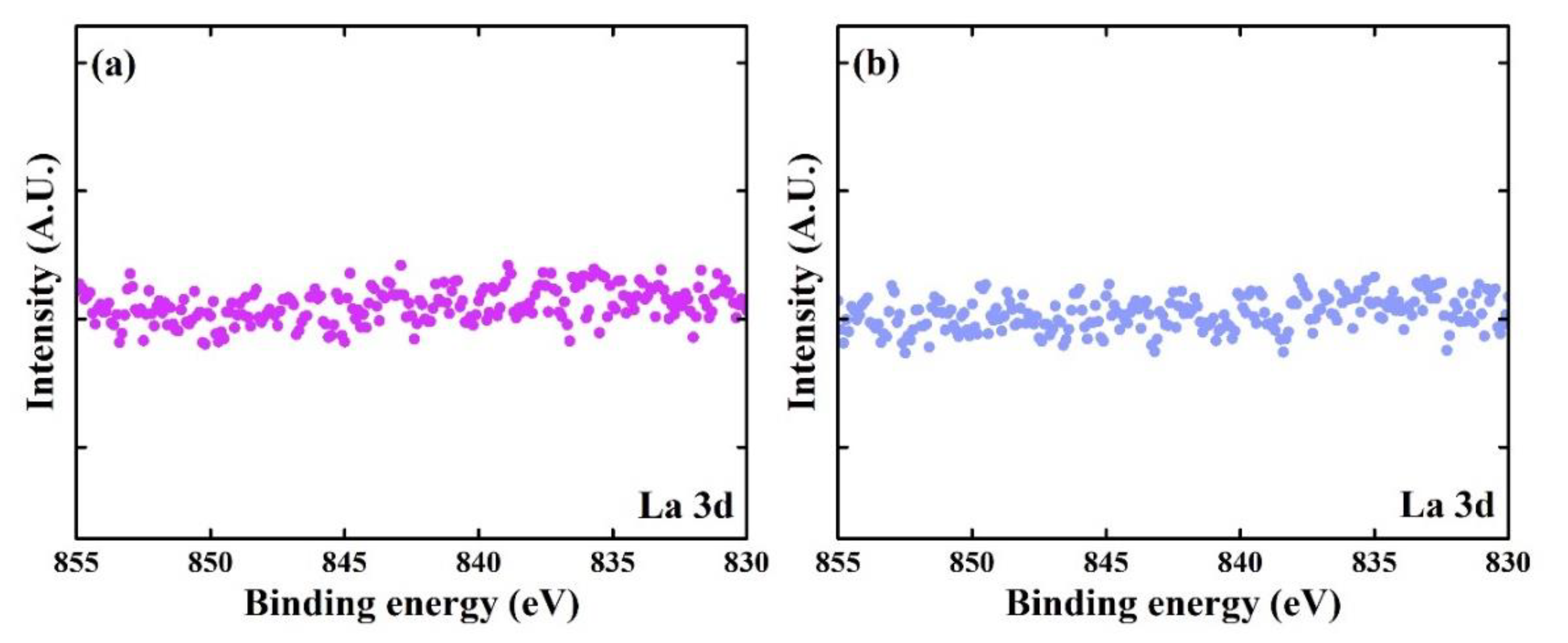

| Oxidant | Preferred Orientation | Diffraction Angle of Preferred Orientation | Crystallite Size from XRD (nm) |
|---|---|---|---|
| H2O | 28.9 | 7.9 | |
| LNS | (111) | 32.1 | 1.7 |
Publisher’s Note: MDPI stays neutral with regard to jurisdictional claims in published maps and institutional affiliations. |
© 2021 by the authors. Licensee MDPI, Basel, Switzerland. This article is an open access article distributed under the terms and conditions of the Creative Commons Attribution (CC BY) license (https://creativecommons.org/licenses/by/4.0/).
Share and Cite
Kim, S.Y.; Jung, Y.C.; Seong, S.; Lee, T.; Park, I.-S.; Ahn, J. Microstructures of HfOx Films Prepared via Atomic Layer Deposition Using La(NO3)3·6H2O Oxidants. Materials 2021, 14, 7478. https://doi.org/10.3390/ma14237478
Kim SY, Jung YC, Seong S, Lee T, Park I-S, Ahn J. Microstructures of HfOx Films Prepared via Atomic Layer Deposition Using La(NO3)3·6H2O Oxidants. Materials. 2021; 14(23):7478. https://doi.org/10.3390/ma14237478
Chicago/Turabian StyleKim, Seon Yong, Yong Chan Jung, Sejong Seong, Taehoon Lee, In-Sung Park, and Jinho Ahn. 2021. "Microstructures of HfOx Films Prepared via Atomic Layer Deposition Using La(NO3)3·6H2O Oxidants" Materials 14, no. 23: 7478. https://doi.org/10.3390/ma14237478
APA StyleKim, S. Y., Jung, Y. C., Seong, S., Lee, T., Park, I.-S., & Ahn, J. (2021). Microstructures of HfOx Films Prepared via Atomic Layer Deposition Using La(NO3)3·6H2O Oxidants. Materials, 14(23), 7478. https://doi.org/10.3390/ma14237478






